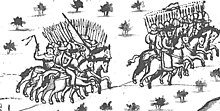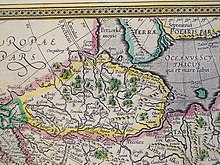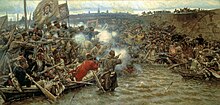Qaschliq

Qaschliq ( Russian Кашлык Kaschlyk ), also Sibir / Sebur or Isker , was the capital of the Sibir Khanate from around 1485 . The archaeological site, located about ten kilometers south of Tobolsk on the banks of the Irtysh , is called today in Russian Kuchumovo Gorodishche ( Kuchum's castle site). The Tobol flows into the Irtysh a good six kilometers northwest of Qaschliq . In 1582 during the conquest of the Siberian Khanate by the Russians , the fortress of Yermak was destroyed.
City history
The area around today's Tobolsk was settled by the Khanty , Mansi , Nenets , Selkupen and Sabiren since the late Bronze Age . The city of Isker was founded before the Mongol invasion of the Rus . The Sabirs called this area east of the Urals Kaschlyk or Sibir. Genghis Khan is to this "northern woodlands" anno 1224 Jochi have assigned as collateral.
In 1367 the city of Isker was mentioned for the first time in western Europe under the name Sebur on the map of the brothers Domenico and Francesco Pizzigano from Venice . Eight years later it was listed under the same name in the Catalan World Atlas . Since the end of the 15th century, Isker was the capital of the Sibir Khanate. After the probably indigenous Taibugids had defeated the Mongolian Scheibanids , they moved the capital of the Khanate from Chingi-Tura to Sibir (Kaschlyk) in 1495 . In 1563 the Scheibanide Kütschüm Khan recaptured the khanate; the capital remained Kaschlyk.
Yermak occupied Qaschliq after the battle of the Chuvash Cape on October 26, 1582 and is said to have made rich booty. Residents and Kuchum fled to the Ishim -Steppe. After Daniil Tschulkow founded the Ostrog Tobolsk in 1587, Qaschliq fell into disrepair. At the beginning of the 20th century the desert consisted of a pile of bricks and stones overgrown with grass and overgrown with trees.
etymology
The ethnic mix in the settlement of the Siberian khanate is reflected in the names of their capital mentioned above:
- Qashlig = Kaschlyk ( Turkish language ): fortress , in the language of the Siberian Tatars winter , village ( Kischlak ).
- Fisker ( obugrisch (in western Siberia on whether spoken Ugric )): is = old, ker = city.
- Sibir = Sebur
Web links
- Panorama Isker
Individual evidence
- ↑ eng. Taibuga
- ↑ Russian Чувашский мыс, see also: Бой на Чувашевом мысу
- ↑ Russian Ишимская степь
- ↑ Russian Даниил Григорьевич Чулков
Coordinates: 58 ° 5 ′ 24 ″ N , 68 ° 18 ′ 36 ″ E

